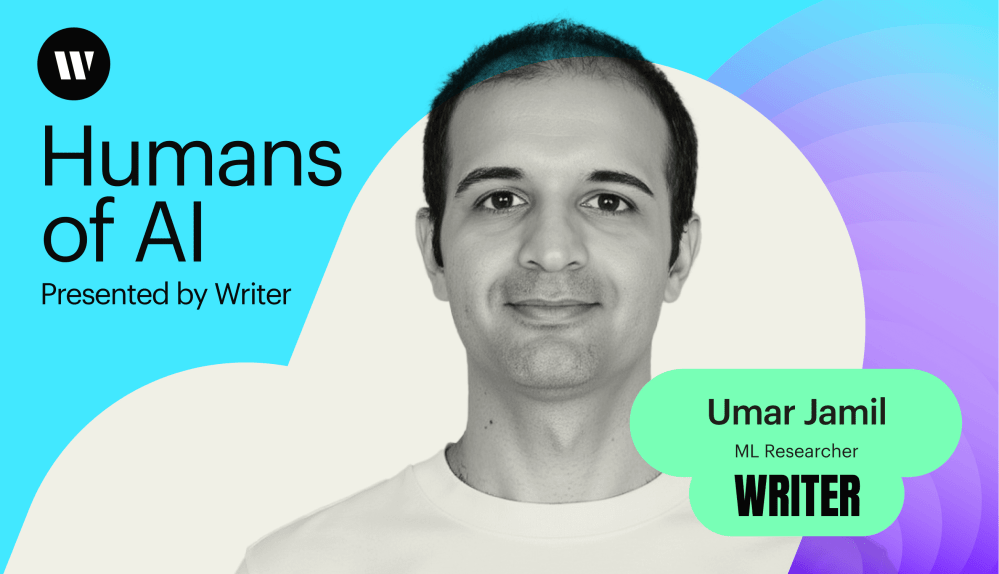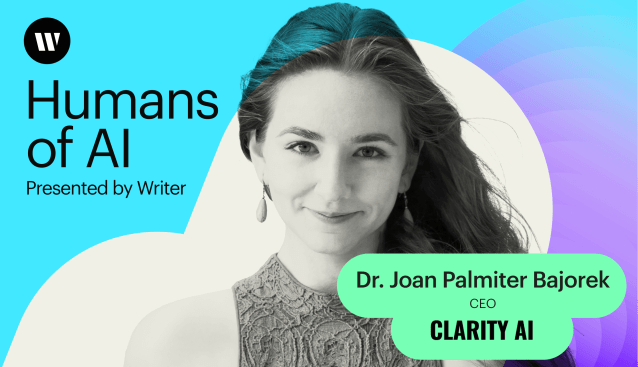Humans in the loop
– 8 min read
Decoding machine learning complexity with WRITER’s Umar Jamil

What if the uninspired, those who simply show up and go through the motions, controlled the future of AI? We might risk squandering AI’s true promise, settling instead for mediocre, uninspired, and irresponsible outcomes. Fortunately, that’s not the world we live in. Meet Umar Jamil, our latest guest on Humans of AI, who embodies the passion and dedication that drives true innovation in AI.
Umar is a machine learning researcher at WRITER, known for his popular YouTube channel where he simplifies complex machine learning concepts. Umar shares his journey from his love of video games to falling in love, and eventually to machine learning, inspired by his wife’s work in the field.
His story teaches us all how hard work, passion, and deep commitment can lead to falling in love, learning new languages, and becoming an expert and leader in ground-breaking technology.
- Despite his long standing interest in AI, Umar’s transition into the field was motivated by his love for languages and his wife’s encouragement.
- Umar believes we aren’t at the point where AI models can reason automatically and stresses the importance of considering the societal impacts of using machine learning models.
- His passion and determination led to the creation of his YouTube channel, where he now demystifies machine learning for over 40,000 subscribers.
- Umar and his team at WRITER are exploring the potential of multimodal models combining different inputs and outputs.
An unlikely love affair with AI
Umar’s journey into the world of AI began in the strategic landscapes of video games. As a young gamer, Umar found the decision-making processes of characters in games like “Rise of Nations” captivating. When you play against the computer, it responds not only based on predetermined rules but also on learning algorithms.
This interest naturally transitioned into Umar wanting to create his own software. So what was his first coding project? A calculator, when he was only 10 years old.
“I didn’t actually understand most of the code that I was writing,” Umar admits. “I was just copying what it was in the book. I was so fascinated with the ability to make things, to make something that wasn’t there yesterday.”
You might think you know what happens next — Umar went to school and began studying neural networks and natural language processing (NLP). Well, think again. Even though Umar had an interest in AI from a young age, it was actually a “meet cute” that set him on his current path.
Umar and his wife’s relationship is the perfect modern-day star-crossed lovers’ tale. Umar, who comes from a traditional Pakistani family, faced expectations to marry within his culture, as did his wife from her Chinese family.
“Making these cultures interact with each other, accept each other, was very difficult for us,” Umar explains. “But if you want something, you can make it work.”
Umar met his wife — a machine learning engineer — while working in China. She was working on text-to-speech generation.
“At the beginning, I wasn’t very familiar with machine learning, despite having some kind of background,” Umar explains. “But as soon as I met her, I started digging deep into what she was doing on a daily basis and how it worked.”
Umar knew he wanted to transition into that space, so he studied to get a master’s degree, quit his full-time job, and dedicated himself entirely to machine learning for roughly eight months.
“I started waking up at 4:00am to study, and I used to study until 9:00pm at night,” Umar says. “It wasn’t hard for me because when you’re passionate about something, when you’re driven, it comes naturally.”
Bridging bytes and languages
It wasn’t just Umar’s love of complexity, coding, and video games that led him here. It was also his love of languages. Umar’s family is from Pakistan, but he grew up in Italy — so he learned Italian and Urdu (the Pakistani national language) as a child. While living in China for four years, he studied Mandarin to better interact with colleagues and customers. And now? He’s studying German.
Learning Mandarin has been especially interesting for Umar. He says he’s always found complicated things fascinating, and when you learn Chinese and study the characters, you’re also learning the country’s history. It also allowed him to interact with the Chinese AI community.
“I interact a lot with Chinese researchers, and they have their own technologies. They have their own research areas and it’s quite impacted my ability to communicate with people,” Umar explains. “Which impacted my machine learning experience because I got to know about this machine learning work that’s happening in China.”
Educating the masses
Umar’s passions and determination — plus his wife’s encouragement — drove him to create his YouTube channel. She admired his ability to simplify complex topics during their conversations about research papers and urged him to share his insights with a broader audience. This blend of personal drive and support led to the inception of his channel, where he now demystifies machine learning for over 40,000 subscribers.
Naturally, we asked him to demystify machine learning for us.
“In machine learning, we have the input and we have the output. What we don’t know is the relationship,” Umar explains. “So for example, in language models, we basically teach a language model to predict what is the next word that’s most likely after a particular prompt — which is the input.”
If you have a sentence and you take the first two words, the third word is what you’d expect the language model to generate when it sees the first two words. You have the relationship between input and output: what you want the model to generate and what you give the model as input. At its core, machine learning is basically a list of techniques that allow you to learn about this relationship by using data.
Finding joy in complexity
Umar finds difficult and challenging problems appealing. He was one of the first individuals to make a video on coding Stable Diffusion from scratch, likely because of how complex the project was. Luckily for Umar, his line of work presents no shortage of challenges for him to explore.
“Machine learning is one of those fields in which you’re never bored because there is always something new every day,” he says. “There will never be a point in which I’ll say, ‘Okay, I know everything and I’m at that end’ because there is always something more.”
At WRITER, Umar and his team are researching how to make large language models more efficient to run and process longer prompts.
Umar says he’s also excited about the prospect of multimodal models.
“Before, for example, you had the image models, text models, audio models,” Umar explains. “Now you have these models that are multimodal and they’re trying to combine all these multi-modalities into one bigger model that can leverage the audio input, the image input, and can output audio, can output images, can output text.”
Looking at the future of AI
As someone who works closely with this emerging technology, Umar says for now, we’re nowhere near the point of “doomsday” that any fear-mongering might lead you to believe. He says we’re not at the point where models can reason automatically — machine learning models are just trying to replicate patterns.
“I don’t think that right now we have the tools or the resources to arrive at a point in which we say, ‘Okay, we went too far’ or ‘We’re going too far,’” Umar says. “I don’t think we’ll have that in the immediate future.”
He thinks a lot about the societal impacts of using machine learning models. AI has often been coined the electricity of the current era. We’re seeing it disrupt and change every industry.
Umar’s story really drives home the importance of passion and love in guiding our lives and work. When you truly care about something, it gives you the guts to take risks — whether that’s switching careers or immersing yourself in a new culture. Letting love lead the way can open up amazing opportunities you never saw coming in a team setting.
We’re always on the lookout for passionate AI/ML researchers to join Umar and the WRITER team. Check out our careers page to learn more.
Want to hear more stories from the humans working at the crossroads of business and generative AI? Subscribe to Humans of AI wherever you listen to podcasts.
The opinions expressed by Umar in the podcast and in Umar’s YouTube channel belong solely to Umar and do not necessarily reflect the views of WRITER.


